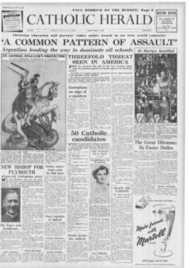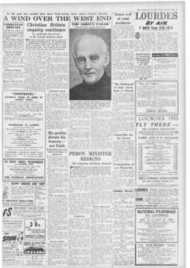Page 7, 22nd April 1955
Page 7

Report an error
Noticed an error on this page?If you've noticed an error in this article please click here to report it.
Tags
Share
Related articles
1 Glastonbury Buys A Tapestry `future May
Ancient Shrine To Be Canonically Re-erected
Statue From The Seal Of Westminster
Apostolic Delegate Unveils New Statue
Rebuilding Will Be More Solid Than Stone
Glorious Glastonbury
Seven Kings once went to Avalon
ROM the design in the centre of the Great Seal of the Abbey of Glastonbury a statue of Our Lady St. Mary has been carved and next July it will be publicly blessed.
Depicdng Our Lady crowned, bearing the Divine Infant on her left arm and carrying a sheaf of roses in her right hand, the statue, carved by Mr. P. Lindsey Clark, Is an authentic reproduction.
To Glastonbury, " a second Rome " where Saxons and Normans revered Our Lady, the Apostolic Delegate, Archbishop O'Hara. will go to bless the statue before High Mass during the Clifton diocesan pilgrimage on July 10.
WATTLE CHAPEL A canonical shrine will be erected in the church after the pilgrimage and the statue installed there.
Arrangements have been made to reproduce prayer cards, pictures and medals and small reproductions of the statue.
The preliminary work was carried out by Mr. E. WhittnarshEveriss, a Bristol Catholic architect.
Glastonbury was when recorded history began.
Before the birth of Our Lord it was counted a holy isle-an isle of the dead. where, beneath The shadow of the Tor, the pagan inhabitants buried their dead. hopeful that their spirits would enjoy a peaceful immortality surrounded by water and marsh.
Joseph of Arimathea, St. Patrick. St. David, are all connected by legend with this hallowed spot By the fifth century an old chapel of wattles stood as a Christian Church. By the year 680 the chapel there was already known as The Church of Our Lady and St. Patrick."
St. Wilfrid of Northumbria brought his Benedictine monks and a great stone monastery was built by St. Dunstan. leaving the " old church untouched.
Monks went out from Glastonbury under St. Roniface to convert the Germans.
" A second Rome " was the name bestowed on Glastonbury by Popes, kings and princes, who showered privileges upon the sanctuary.
From earliest ages Glastonbury. c: "Avalon," was a pilgrimage centre. At least seven Kings and Queens of England went there. The Black Prince visited it before the Battle of Poitiers. Scholars, like Erasmus, were constant visitors. king Arthur was buried there.
With the martyrdom of Blessed Abbot Whiting and his cornpanions, Glastonbury was still further hallowed. But desolation fell and the Church was driven underground.
ON THE TOP Four centuries Inter the Catholics of the Clifton diocese, led by Bishop Rudderham, will by public profession of their Faith show that their love of Our Lady is no less than their remote ancestors, and they will pray that in God's good time Our Lady St. Mary of Glastonbury will once again be at the heart of Catholic England.
Pilgrims will gather on the Tor by 1.45 p.m. and the ceremonies will begin as usual with the Stations of the Cross. The 14 Crosses will have been erected on their arrival from various parts of the diocese.
blog comments powered by Disqus









